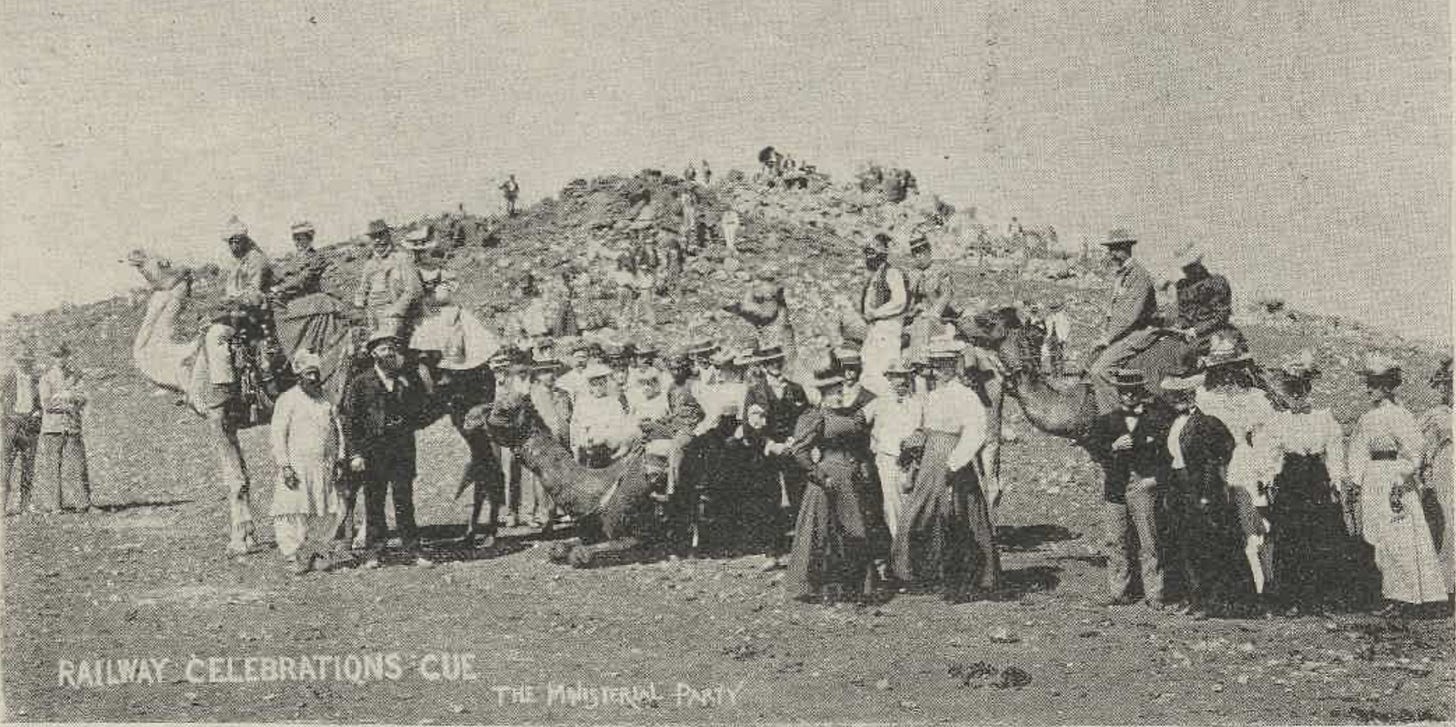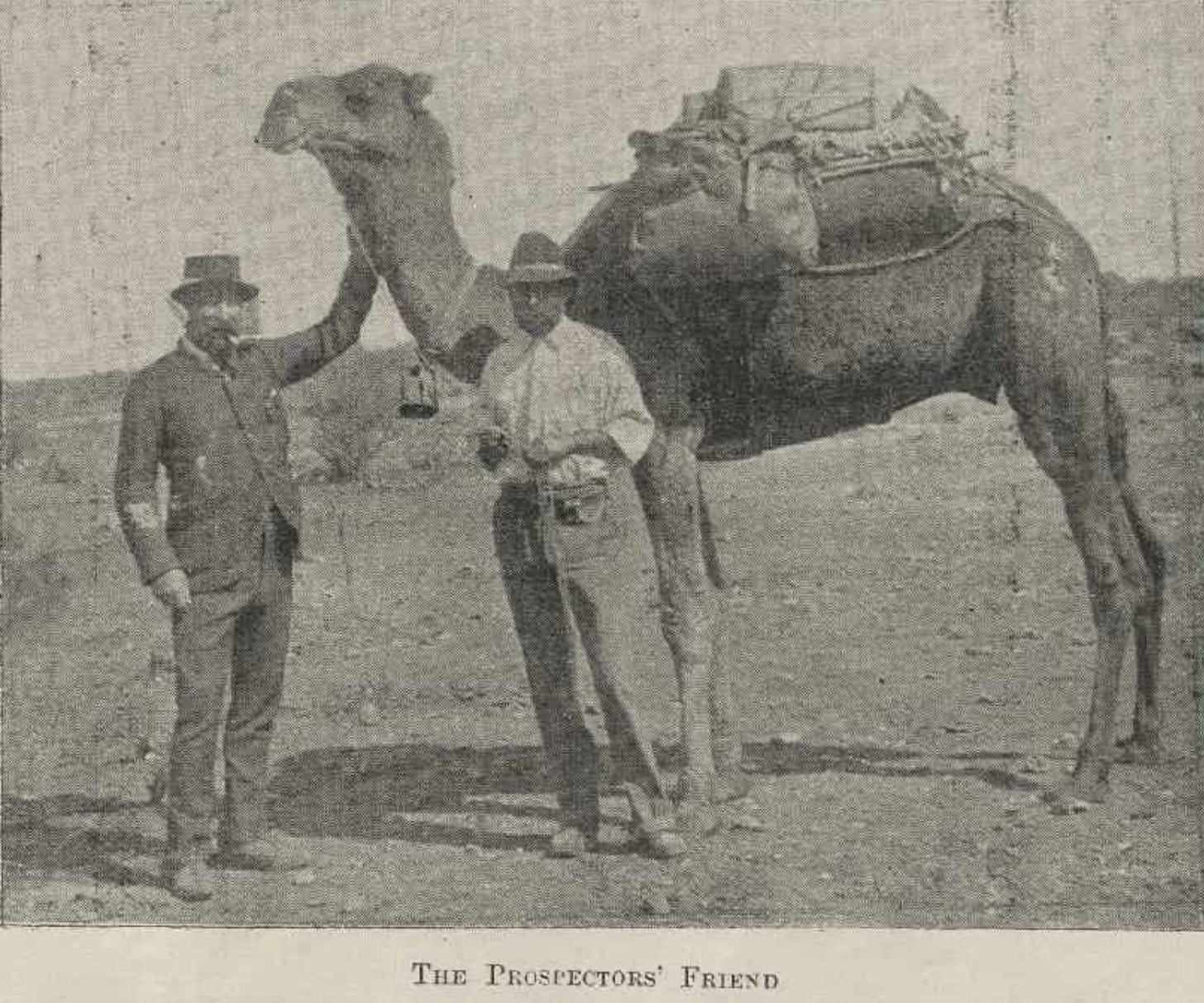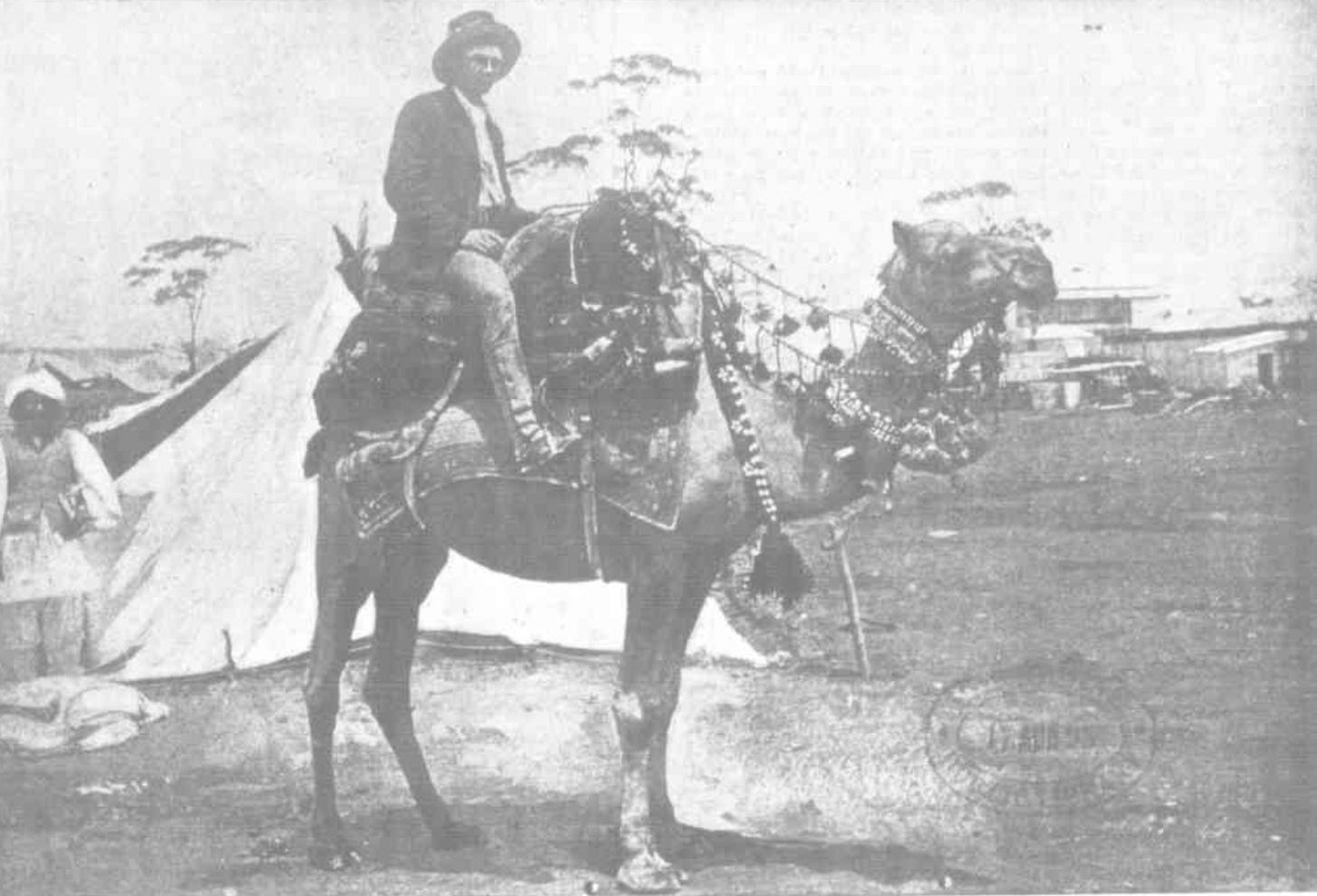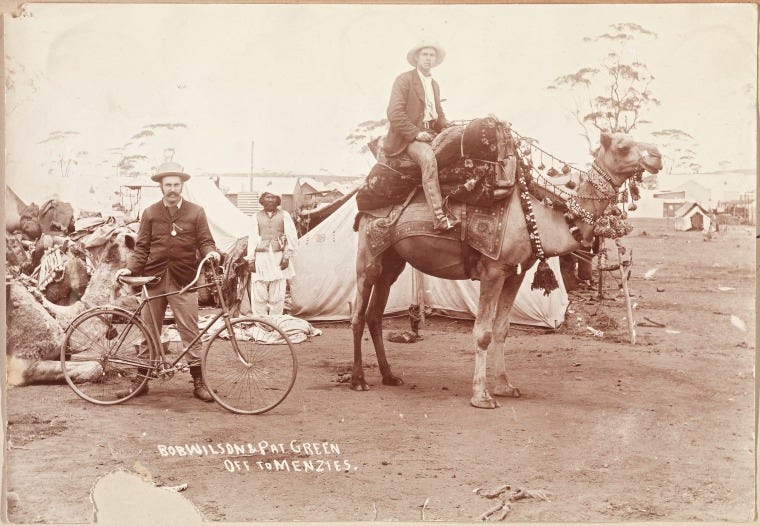A Camel Named Larl
A record-breaking camel on the eastern goldfields.
There is no track, and as the country is dense scrub and sand hills, you might go within a few hundred yards of the spot and miss it easily. A number of parties had started out from the 90-Mile [Goongarrie] two or three days before I got there, but they had failed to strike Menzies’ Camp. On the Friday after I got there, three men with camels arrived and pegged out a couple of blocks adjoining mine. Until a track is made and condensers go out, it would be the greatest folly for any one to rush to the find unless camels are employed. [1894]
Early prospectors quickly learned that the harsh environment of outback Western Australia was not well-suited to horses. If they wanted to travel to remote locations where there was limited water, they needed camels. The first shipments of the animals arrived in the early 1890s, and prospectors soon utilised them to search for gold.
Camels and their handlers (known as the Afghan cameleers) were “intimately associated with the development of the West Australian goldfields.” They were pivotal to enable the prospectors to travel long distances in harsh locations with heavy supplies. Photographs taken during that time period demonstrate the camels’ importance. While not necessarily the main subject, they were nearly always photographed alongside people. It is clear they were considered an extension of the prospectors and the goldfields and were the reason they were able to access the wealth that lay within the land. They were, as one photograph was labelled in 1897, “the prospectors’ friend.”

A simple search on Trove reveals many photos of camels taken during the 1890s. People recorded milestones such as the arrival of a camel team in a town or the start of a prospecting expedition. While it is not uncommon to come across photos of camels, it is uncommon to see them named. As I searched for a photo of the Carbine Hotel in Menzies, I stopped what I was doing when I saw a photo of Larl in The Australasian (Victoria).
To research the history of a camel, we must research the history of a man. William Robert Wilson, a businessman with interests in mining in Broken Hill, New South Wales, was Larl’s owner. William arrived in Western Australia in the early 1890s during the Murchison gold rush and was part of the Octagon Syndicate, which owned a mine at Day Dawn. While he did visit the goldfields, most of the prospecting work was carried out by men he employed, such as Douglas Hall.
Wilson’s syndicate bought Larl (first known as Tallah) in 1894. Most people knew him as the “famous riding camel of the Murchison.” He set the record for travelling from Coolgardie to Menzies (110 miles) in 16 hours and was known to travel 200 miles “in a pinch.”
In 1894, as Douglas Hall’s prospecting party travelled near Mount Margaret, they met with resistance from the Wangkatja people. They threw spears at the men and injured two, including Griffo Wallace, who was speared through the lungs. Realising the seriousness of the wound, Douglas put Griffo on the camel’s back and rode at full speed to the camp at the junction. Larl was said to be instrumental in saving Griffo’s life.
Due to his speed, Larl also made a superb racing camel. Richard Casey rode him in a race from Coolgardie to Londonderry against the Earl of Fingall in September 1894. Richard was recovering from illness and received a 25 minute head start. He took off on Larl (who went by the back track), while the Earl of Fingall’s camel went straight through the scrub. Despite the small advantage, when Richard finally arrived, he found the Earl drinking a brandy and soda. It was, The Australasian noted, the only race Larl ever lost.
Perhaps one of the last references to Larl was in January 1896. Also living in Menzies was William’s nephew, Robert (Bob) Henry Wilson. During a Boxing Day sports gathering, he rode Larl in the camel race and came first. In second place, and in what may be a clue regarding Larl’s life, was ‘Little Larl.’
If you find photos in the newspapers, it is always worthwhile checking library catalogues to see if the originals exist. As it turns out, a photo of Larl (without his name) is part of the State Library of Western Australia’s collection. Written on the image are the words “Bob Wilson & Pat Green off to Menzies.” While it is incredibly similar to the photo in The Australasian, tiny differences in the background indicate that there were two different photos taken in a slightly different position.
Over time, the camel’s usefulness for life on the goldfields diminished. Other methods of transportation came into being, and once the car came along in the 1920s, they fell further from use. People released camels that they no longer needed into the outback. It was those decisions that resulted in today’s problems. Camels are feral animals in Western Australia, with an estimated population of over one million. The Wilsons treated Larl with importance in the 1890s, but we have no way of knowing if he faced a similar fate. With a lifespan of 40 years, he may have still been alive in the 1920s. Somewhat disturbingly, if he did breed, his progeny might be roaming the outback today.
Pledge Your Support
Researching and writing stories for The Dusty Box is a labour of love. Unfortunately, it can also be a costly labour of love. While I will always endeavour to have free stories available (history, after all, should be for everyone) if you have the means to do so, please consider becoming a paid subscriber. It’s $50 for a year - a bargain that equates to just over $4 a month (coffee isn’t even that cheap anymore!). To pledge your support, tap the button below.
Sources:
1894 'Mining.', The Golden Age (Coolgardie, WA : 1894 - 1898), 10 October, p. 2. , viewed 07 Feb 2025, http://nla.gov.au/nla.news-article256740121
1897 'OUR MEMBER.', The Geraldton Express and Murchison and Yalgo Goldfields Chronicler (WA : 1896 - 1905), 26 March, p. 40. (Supplement to the "Geraldton Express"), viewed 08 Feb 2025, http://nla.gov.au/nla.news-article261203384
1897 'CUE', The Geraldton Express and Murchison and Yalgo Goldfields Chronicler (WA : 1896 - 1905), 26 March, p. 58. (Supplement to the "Geraldton Express"), viewed 08 Feb 2025, http://nla.gov.au/nla.news-article261203382
1897 'PROSPECTING EXPEDITION.—THE START.', The Geraldton Express and Murchison and Yalgo Goldfields Chronicler (WA : 1896 - 1905), 26 March, p. 6. (Supplement to the "Geraldton Express"), viewed 08 Feb 2025, http://nla.gov.au/nla.news-article261203387
1895 'LARL, THE "RECORD CAMEL."', The Australasian (Melbourne, Vic. : 1864 - 1946), 17 August, p. 27. , viewed 09 Feb 2025, http://nla.gov.au/nla.news-article139713603
1894 'Local and General.', The Western Australian Goldfields Courier (Coolgardie, WA : 1894 - 1898), 15 September, p. 2. , viewed 09 Feb 2025, http://nla.gov.au/nla.news-article253045835
1894 'Local and General.', The Western Australian Goldfields Courier (Coolgardie, WA : 1894 - 1898), 22 September, p. 2. , viewed 10 Feb 2025, http://nla.gov.au/nla.news-article253045954
1896 'Sports at Menzies.', Coolgardie Pioneer (WA : 1895 - 1901), 8 January, p. 5. , viewed 10 Feb 2025, http://nla.gov.au/nla.news-article251481848
State Library of Western Australia; Bob Wilson and Pat Green off to Menzies; Sanderson, Archibald, 1870-1937; Call Number: 400B/50
1894 'THE GOLDFIELDS.', The Australian Advertiser (Albany, WA : 1888 - 1897), 12 September, p. 3. , viewed 13 Feb 2025, http://nla.gov.au/nla.news-article260678662





Very Interesting story about the Camels 🐫🥰